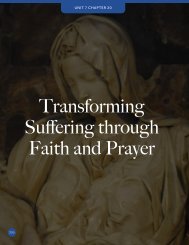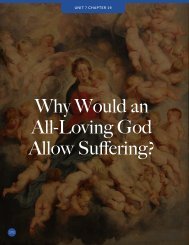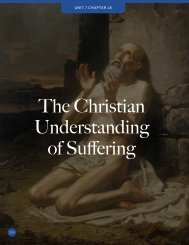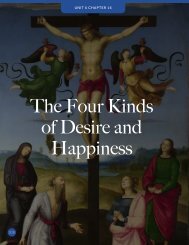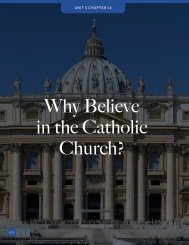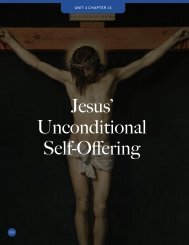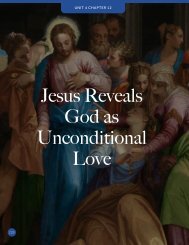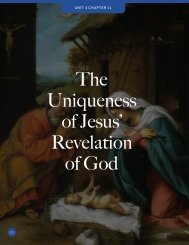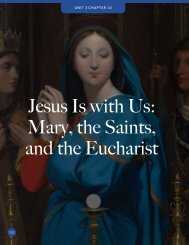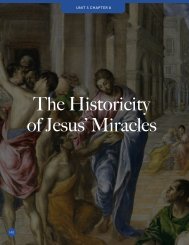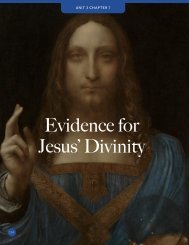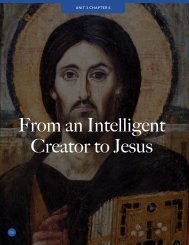CFS-WB-CH04
You also want an ePaper? Increase the reach of your titles
YUMPU automatically turns print PDFs into web optimized ePapers that Google loves.
UNIT 2 CHAPTER 4
Philosophical
Proofs of an
Intelligent
Creator
68
Chapter 4 Overview
The term philosophy, from Greek for “love of wisdom”, refers to a reasoned study of the truth of things. We
have grasped the truth when what exists and what we think exists are the same. Philosophers and scientists
alike seek to understand the universe as it really is, or, in other words, to know the truth about the universe.
The great Medieval philosopher St. Thomas Aquinas believed that philosophy could tell us a lot about God. St.
Thomas is famous for using logical reasoning to prove God’s existence: there must be one uncaused being
which creates everything else, and this reality is referred to as “God.” Using St. Thomas’s reasoning, we can
simply look at the world around us and, by using our intellect, conclude that there must be a Creator.
In this chapter you will learn that …
■ Philosophy is the love of wisdom and can be used to come to reasonable knowledge of God.
■ St. Thomas Aquinas demonstrated by way of five proofs for God’s existence that there must be one
uncaused, unrestricted being who caused everything else.
■ Contemporary philosopher Bernard Lonergan has developed a new proof for God’s existence that
focuses on the intelligibility of reality: God is the complete set of correct answers to the complete set of
questions.
■ Philosophical proofs for God can tell us what God is — the Creator, the unique uncaused reality existing
through itself, unrestricted in intelligibility and in intelligence — but they are limited in what they can tell us
about who God is.
Bible Basics
The fear of the LORD is the beginning of wisdom,
and the knowledge of the Holy One is
insight.
— Proverbs 9:10
For what can be known about God is plain to
them, because God has shown it to them. Ever
since the creation of the world his invisible nature,
namely, his eternal power and deity, has
been clearly perceived in the things that have
been made.
— Romans 1:19–20
© Sophia Institute for Teachers
Connections to the Catechism
■ CCC 31–53
■ CCC 154–159
■ CCC 237
■ CCC 274
■ CCC 286
The text of St. Thomas Aquinas’ First and Second
Ways are excerpted from the Project Gutenberg
eBook edition of the Summa Theologica, Part I
(Prima Pars) From the Complete American Edition,
translated by the Fathers of the English Dominican
Province (1947).
69
Chapter 4
Aa
VOCABULARY
Philosophy: The study of
ultimate reality and its causes
by human reason alone. From
the Greek word philosophia,
which means “love of wisdom.”
Five Ways: Five arguments
developed by St. Thomas
Aquinas that use human
reason and observation of the
created world to conclude that
God exists. Also called the
“five proofs for the existence
of God.”
The Love of Wisdom
The term philosophy comes from the Greek word philosophia, which
means “love of wisdom,” but is commonly used today to mean “worldview.”
For example, you may have been asked, “What is your philosophy
of life?” That modern meaning is not how we are using the word here.
Instead, we will use its actual meaning: a reasoned study of the truth of
things.
The great Medieval philosopher St. Thomas Aquinas believed that
philosophy could tell us a lot about God. St. Thomas is famous for using
logical reasoning to prove God’s existence: there must be one uncaused
being which created everything else — and this reality is referred
to as God. Using his “Five Ways,” or five proofs for God’s existence, we
can simply look at the world around us and, by using reason, conclude
the existence of the Creator.
Before we delve into the arguments themselves, it would be beneficial
to understand what a philosophical proof is and how it works. To
begin, bear in mind that philosophical proofs function differently than
the scientific method, which relies upon empirical data and experimentation
for proof. Philosophical proofs depend upon logic as well as formulated
premises, which are readily verifiable or proven by a prior argument.
For a philosophical proof to be valid (true), the logic must be
sound, and the premises of the argument must be verifiable in some
way. Philosophical proofs can be challenging to understand, but they
are valid even if we may not fully comprehend them. The same is true of
the scientific method. For example, just because one does not understand
the law of thermodynamics does not mean the law does not exist.
The same is true when it comes to proving God’s existence.
The most basic structure of a philosophical proof has two premises
and a conclusion. We call the first premise the major premise, and
the second the minor premise. A proof ends with a conclusion that
follows logically (in other words, it must be true) from the rational coherence
of the two premises. If the premises are true, the conclusion
must be true. The conclusion can then become a premise to another
proof, and so on.
Armed with this understanding of how a philosophical proof works,
let us now turn specifically to Aquinas’ Five Ways and a more modern
argument for God’s existence.
70 Apologetics I: The Catholic Faith and Science
© Magis Center
To disprove the arguments
Aquinas puts forth in the
Summa Theologiae, one must
either argue one or more of
his premises are false, or find a
flaw in his logic.
St. Thomas Aquinas Confounding Averroes, by Giovanni di Paolo.
Aquinas’ Five Ways
Aquinas follows the above method to go from what is near and verifiable
to our experience to something which is not a self-evident truth,
namely, that God exists. We will consider the first two arguments in
Aquinas’ own words and the others in summary.
The First Way
The first … is the argument from motion.
■ Simple observation: It is certain, and evident to our senses, that in
the world some things are in motion.
■ Major premise A: Now whatever is in motion is put in motion by
another, for nothing can be in motion except as it is in potentiality to
that towards which it is in motion; whereas a thing moves inasmuch
as it is in act. For motion is nothing else than the reduction of
something from potentiality to actuality.
© Sophia Institute for Teachers
Unit 2, Chapter 4: Philosophical Proofs of an Intelligent Creator
71
■ Major Premise B: But nothing can be reduced from potentiality
to actuality, except by something in a state of actuality. Thus that
which is actually hot, as fire, makes wood, which is potentially hot, to
be actually hot, and thereby moves and changes it.
■ Minor premise A: Now it is not possible that the same thing should
be at once in actuality and potentiality in the same respect, but only
in different respects. For what is actually hot cannot simultaneously
be potentially hot; but it is simultaneously potentially cold. It is
therefore impossible that in the same respect and in the same way
a thing should be both mover and moved, i.e. that it should move
itself. Therefore, whatever is in motion must be put in motion by
another.
St. Thomas’s systemic proofs
have instructed Christians for
centuries.
■ Minor premise B: If that by which it is put in motion be itself put in
motion, then this also must needs be put in motion by another, and
that by another again. But this cannot go on to infinity, because then
there would be no first mover, and, consequently, no other mover;
seeing that subsequent movers move only inasmuch as they are
put in motion by the first mover; as the staff moves only because it
is put in motion by the hand.
■ Conclusion: Therefore, it is necessary to arrive at a first mover, put
in motion by no other; and this everyone understands to be God.
Saints Peter the Martyr and Thomas Aquinas Refute the Heretics, by Andrea Di Bonaiuto.
72 Apologetics I: The Catholic Faith and Science
© Magis Center
Key to understanding Aquinas’ first proof is properly understanding
his terms. By “motion,” Aquinas means not just movement but change.
So, Aquinas’ initial observation is perhaps better understood to our
modern ear as “It is clear that there is change all around us in the world.”
Things move, or change, from one state to another. A ball moves, or
changes, from a state of not moving to rolling down a hill. An object in
its beginning state (before a change) cannot be in its ending state (after
the change) at the same time. Something which is cold (with atoms
not excited) cannot be something hot (with atoms excited) at the same
time.
Furthermore, before a change, an object is said to be in potency
(or potentiality) to its changed state (ending state). After the change,
the object is said to be in act (actualized) to this changed state. So, we
might describe change as a transition from potency to act. Using the
examples above, a ball is potentially rolling down the hill until it is actually
rolling down the hill. A cold object (which has only the potency to be
hot) transitions from its state of potency (coldness) to act (hotness).
Something possible (in potential) can only come to be by something
actual. For example, when you kick a ball, the ball cannot move
on its own unless something in motion strikes it, like your foot. An object
which is in potency to a new changed state must be moved (acted
upon) by something else to transition from potency to act (its new
changed state), because it cannot move itself to what it does not have.
Remember, since the object is not yet in the new changed state, it cannot
give itself what it does not have. Therefore, something else, a mover,
will have to move it to where it cannot go by itself.
This gives rise to the question of whether the mover is itself something
which needs to be moved from potency to act. If so, then it too
would need a mover to bring it from potency to act. This would be
the case for all other movers that need to be moved from potency to
act — all of them would need movers. Can we go back through an infinite
number of movers? No, we cannot, because an infinity of movers can
never be actualized. By definition, infinity stretches on forever. If you
were told that in order to get a million-dollar reward, you have to take an
infinite number of steps, you would say, “Hey, that’s not fair, because an
infinite number of steps is impossible to complete — it can never be actualized.
It simply can’t be done.” Now, if an infinite number of steps can
never be actualized, then we cannot say that an infinite number of steps
were completed to move a particular object from potency to act — the
object would never be moved. It would still be awaiting the infinite number
of steps to be completed (and will always be waiting), because an
Potency: In metaphysics, the
capacity to act or change, or a
possibility a thing can be said
to have.
Act: In metaphysics, the
motion, or change, that
reflects the fulfillment of a
possibility in a thing.
Something
possible (in
potential) can
only come to be
by something
actual.
© Sophia Institute for Teachers
Unit 2, Chapter 4: Philosophical Proofs of an Intelligent Creator
73
First Mover: The necessary,
uncaused being, or God, who
first set everything in motion.
If there were
no first cause
that put
everything in
motion, nothing
whatsoever
would move.
infinite number of steps is not completable. So, what does this mean?
There must be a First Mover.
What, then, must a first mover be like? It cannot be something that
needs to be moved from potency to act, otherwise it would itself require
a mover. Additionally, the first mover must have the capacity to
move all other objects to act, because it is the source (first) to move all
subsequent changes from potency to act.
The key principle of Aquinas’s argument is underlined and is necessarily
true: “But this cannot go on to infinity, because then there would
be no first mover, and, consequently, no other mover.” What is true of
one thing in motion (change) is true of the collective motion (change)
of the entire universe. If there were no first cause that put everything
in motion, nothing whatsoever would move. There would be no motion
(change) in anything, so there must be an unmoved mover that set everything
else into motion. This First Mover is God. Let us look at the
second proof, which builds upon the first and strengthens it.
The Second Way
The second way is from the nature of the efficient cause.
■ Simple Observation: In the world of sense [like sight], we find there
is an order of efficient causes.
■ Major premise: There is no case known (neither is it, indeed,
possible) in which a thing is found to be the efficient cause of itself;
for so it would be prior to itself, which is impossible.
■ Minor premise A: Now in efficient causes it is not possible to go
on to infinity, because in all efficient causes following in order, the
first is the cause of the intermediate cause, and the intermediate is
the cause of the ultimate cause, whether the intermediate cause be
several, or only one. Now to take away the cause is to take away the
effect.
■ Minor premise B: Therefore, if there be no first cause among
efficient causes, there will be no ultimate, nor any intermediate
cause. But if in efficient causes it is possible to go on to infinity,
there will be no first efficient cause, neither will there be an ultimate
effect, nor any intermediate efficient causes; all of which is plainly
false.
■ Conclusion: Therefore, it is necessary to admit a first efficient
cause, to which everyone gives the name of God.
This argument is similar to the first but arrives at its conclusion by a
different route. Whereas the first way is rooted in the observation that
74 Apologetics I: The Catholic Faith and Science
© Magis Center
things are in motion, or change, the second way is concerned about the
cause of that change. In fact, borrowing from the ancient Greek philosopher
Aristotle, Aquinas believed that all things that are actualized (that
is, change from potency to act) have four causes for that change. One
of those causes is the efficient (or agent) cause. An efficient cause
is like an agent that causes other things to happen in some way. For
example, an architect must imagine the house before he draws it. The
idea of the house in the architect’s mind is a cause of the house she
draws on paper. But what caused the thought (idea) of the house in the
first place? That would be the will of the architect who chooses to think
of an idea for a house before drawing it. The architect is thus the efficient
cause of the actual house someone builds, even if she did not
build it herself.
Like the first argument, efficient causes cannot go on infinitely
into the past. There must be a first efficient cause — an eternal first
cause — that did not come to be by anything else, but just is. God is the
name we give to that first efficient cause.
Efficient Cause: In
philosophy, the agent who
brings a thing into being or
initiates a change.
An architect who conceives
and designs a house is the
efficient cause of that house,
even if she does not build it
herself.
Image courtesy Shutterstock.
© Sophia Institute for Teachers
Unit 2, Chapter 4: Philosophical Proofs of an Intelligent Creator
75
The Third Way
Let us now look at Aquinas’ third proof, which deals with what we might
call the limited life cycle of things. Aquinas calls this way the argument
from possibility and necessity. It is possible for things to exist, and to
not exist. A tree, for example, grows from a planted seed, flourishes for
a time, but eventually dies, decays, and ceases to be. He notes that all
around us are things that come to be and cease to exist. Such beings do
not have to exist, and therefore, are not existence itself. If a being is not
existence itself, it does not exist through itself, but rather exists through
something else — it is caused by something else. If everything in reality
were caused by something else, then the whole of reality itself would
have to be caused by something else. There is, however, by definition,
nothing else outside the whole of reality. Thus, there must be a being in
the whole of reality that does not need a cause of its existence. If there
were no uncaused being in the whole of reality then the whole of reality
would not exist, which is plainly false. Therefore, there must be a being
which is uncaused — which exists through itself because it is existence
This artist depicts Christ’s
blessing of St. Thomas,
between Plato and Aristotle.
Triumph of St. Thomas Aquinas, “Doctor Communis”,
between Plato and Aristotle, by Benozzo Gozzoli.
76 Apologetics I: The Catholic Faith and Science
© Magis Center
itself — a necessary being. This necessary being (existence itself) is
something that has always existed with no beginning or end and did not
receive its existence from something else — something that never came
to be because it always is. Without such a being, there would be nothing
at all. We call this necessary being God.
Teleology: The study of ends
or final causes.
The Fourth and Fifth Ways
These first three arguments — the most important for our purposes
here — establish the foundation for the last two. Aquinas constructs
the last two with the first three in mind. We have already considered in
some detail the core aspects of Aquinas’ fourth way in Chapter 2: the
argument from degrees of perfection. His fifth way, on the governance
of the world, shows that the goal-oriented nature of all animate creatures
— what philosophers refer to as teleology — requires an agent
that moves all things intelligently to their proper end. Aquinas calls this
movement of all things to their purpose and perfection the Eternal Law
[the wisdom] of God.
Aquinas’s five proofs together provide a convergence of logical arguments
that help the mind grasp the existence of God. We first begin
with what we can observe with little difficulty. Then from there, we must
ask from where these phenomena (things we observe) come from in
the first place.
God Is the Answer to All Questions
As modern science has expanded beyond the limits of materialism, the
contemporary philosopher Bernard Lonergan has developed a new
proof for God’s existence that focuses on the intelligibility of reality.
When we ask the question, “Why?” we want to know why reality is
this way instead of some other equally possible way. So, for example,
when I ask, “Why did I grow up to be 5 feet 11 inches tall?” I recognize
that I could have been shorter or taller than that, but there must be
some cause to explain why this possibility is real, while the other ones
are not.
What Lonergan realized is that these sorts of questions about
causation can only be ultimately answered by an uncaused reality. Recall
from Aquinas’ third proof that an uncaused reality must be existence itself,
or as St. Thomas says, “existence through itself.” Recall also that
this uncaused reality must be the cause of every caused reality in the
whole of reality. Now if something causes the existence of another reality,
it must also have the explanation of why that other reality is the way
Aquinas’s five
proofs together
provide a
convergence
of logical
arguments
that help the
mind grasp the
existence of
God.
© Sophia Institute for Teachers
Unit 2, Chapter 4: Philosophical Proofs of an Intelligent Creator
77
it is rather than some other way. Therefore, the cause of something’s
existence is its ultimate explanation. Now in as much as the uncaused
reality (existence itself which exists through itself) is the ultimate cause
of all other realities (which could have been some other way because
they are not existence itself), the uncaused reality must also be the ultimate
explanation for why everything else is the way it is, and not some
other way.
We can restate this as follows: the answer to the question about why
I could have been taller or shorter than I am lies in other realities outside
of me. If those other realities do not exist through themselves, then the
answer to the question about why they exist would lie in still other realities
beyond themselves. As you can see, this chain of questions and
answers will not come to a complete answer (a complete explanation to
the question “Why?”) until we reach an answer that explains itself completely
— that is, an uncaused reality.
The chain of
questions will
not come to
a complete
answer until
we reach an
answer that
explains itself
completely.
The Complete Set of Correct Answers to the
Complete Set of Questions
Recall, that the uncaused reality must be able to provide an ultimate answer
to the question, “Why?” this reality existing through itself (which
has no limitation to its existence) does not simply explain its own existence
but explains the existence of everything else that could possibly
be. It contains within itself the answers to all possible questions — and so
we say that this reality is perfectly intelligible. It is the complete set of
correct answers to the complete set of questions.
We now come to the culmination of Lonergan’s argument. He
proves that there is only one kind of reality that can be the complete
set of correct answers to the complete set of questions — an unrestricted
act of thinking. He shows this through a process of elimination. First,
he considers whether a material thing could contain the complete set
of correct answers to the complete set of questions. Of course, this
cannot be, because any material reality has limits in space, time, dimension,
power, qualities, and so forth. Such realities can only answer a very
small number of questions. Then, he considers collections of material
realities, such as a universe, a hypothetical multiverse, or some other
grouping of multidimensional material realities, but these too have
spatial limits, temporal limits, limits to power and qualities which prevent
them from containing the complete set of correct answers to the
complete set of questions. Since material realities will never be able to
answer every question, Lonergan turns to immaterial realities such as
78 Apologetics I: The Catholic Faith and Science
© Magis Center
Philosopher in Meditation, by Rembrandt van Rijn.
acts of thinking. Be careful not to confuse an act of thinking with a material
brain. Such a material reality could not contain the complete set
of correct answers to the complete set of questions. Rather, he asserts
that the act of thinking is immaterial — like the soul that emerges from
our clinically dead body during a near death experience. This soul-like
immaterial act of thinking would not be like our limited acts of thinking
but would have enormous intellectual capacity — indeed an unrestricted
intellectual capacity to contain the complete set of correct answers to
the complete set of questions.
So what has Lonergan demonstrated? He shows that the uncaused
reality (existence itself which exists through itself) is not only the creator
of the rest of reality, but also an unrestricted immaterial act of thinking
which contains the complete set of correct answers to the complete set
of questions. When we combine Aquinas’ third proof with Lonergan’s
proof, we arrive at the following conclusion: there must exist one uncaused,
unrestricted act of consciousness or thinking which is the ultimate
cause of the existence and intelligibility of everything else that
exists, which we call God.
Scientists, philosophers, and
theologians through the ages
have compared complete
knowledge to knowing the
mind of God.
© Sophia Institute for Teachers
Unit 2, Chapter 4: Philosophical Proofs of an Intelligent Creator
79
Conclusion
Notice that all these proofs for God’s existence — and the many others
we did not discuss here — only conclude that God exists and that he is
unique, uncaused, unrestrictedly intelligent and a creator. They tell us
what God is — the Creator, the unique uncaused reality existing through
itself, unrestricted in intelligibility and in intelligence — but they are limited
in what they can tell us about who God is. For example, we could
never discover the Father revealed to us by Jesus in the Parable of the
Prodigal Son. Logical proofs and scientific evidence are powerless to
probe the heart of the unrestrictedly intelligent God.
While it is unlikely that one single philosophical proof will be wholly
convincing to a non-believer, many proofs and sets of scientific evidence
taken together do provide intriguing demonstrations of evidence
for God’s existence difficult to deny. Yet there are still many
unanswered questions. Does this God love us, or is He indifferent to us
(as Aristotle and Einstein thought)? Is there a Heaven or a Hell? Are we
a special creation of God? Reason and science cannot give us the answers
to these questions. To know these things, God will have to reveal
Himself to us — and so we will have to seek not only the evidence from
reason and science, but also that of God’s self-revelation — specifically,
the revelation of Jesus Christ.
Ancient philosophers used
reason to arrive at the
existence of God, but were
left with many unanswered
questions about who He is.
The Death of Socrates, by Jacques Louis David.
80 Apologetics I: The Catholic Faith and Science
© Magis Center
Focus and Reflection Questions
1 What does the word philosophy mean?
2 What did St. Thomas Aquinas famously use philosophy to prove?
3 What do philosophical proofs depend on? What is needed for a proof to be true? What is the most
basic structure of a philosophical proof?
4 In Aquinas’ First Way, what does he mean by “motion”? What is his initial observation?
5 How does Aquinas use the concepts of potency and act to prove that God must exist?
6 What is an efficient cause in Aquinas’ Second Way? How does he prove God’s existence using
efficient causality?
7 According to Aquinas’ Third Way, why is God the one necessary being in all existence?
8 In Aquinas’ Fifth Way, what is required by the goal-oriented nature of all animate creatures?
9 Why does Lonergan argue that there must be an uncaused reality that we call God?
10 According to Lonergan, why can’t any material thing or any material realities provide a complete set
of answers to a complete set of questions?
11 What can we conclude by combining Aquinas’ Third Way with Lonergan’s proof?
12 What do the proofs for God studied in this chapter ultimately tell us about God? What are they
unable to tell us?
13 While it is unlikely that any one single philosophical proof will be wholly convincing to a non-believer,
what can they provide when taken together?
© Sophia Institute for Teachers
Unit 2, Chapter 4: Philosophical Proofs of an Intelligent Creator
81
Straight to the Source
ADDITIONAL READINGS FROM PRIMARY SOURCES
Fides et Ratio 36, an Encyclical Letter of Pope St. John Paul II, September 14, 1998
36. One of the major concerns of classical philosophy was to purify human notions of God of mythological
elements. We know that Greek religion, like most cosmic religions, was polytheistic, even to
the point of divinizing natural things and phenomena. Human attempts to understand the origin of the
gods and hence the origin of the universe find their earliest expression in poetry; and the theogonies
remain the first evidence of this human search. But it was the task of the fathers of philosophy to bring
to light the link between reason and religion. As they broadened their view to include universal principles,
they no longer rested content with the ancient myths, but wanted to provide a rational foundation
for their belief in the divinity. This opened a path which took its rise from ancient traditions but allowed
a development satisfying the demands of universal reason. This development sought to acquire a critical
awareness of what they believed in, and the concept of divinity was the prime beneficiary of this.
Superstitions were recognized for what they were and religion was, at least in part, purified by rational
analysis. It was on this basis that the Fathers of the Church entered into fruitful dialogue with ancient
philosophy, which offered new ways of proclaiming and understanding the God of Jesus Christ.
1 What was a major concern of classical philosophy? Explain.
2 What does Pope St. John Paul II say was the earliest expression of the human search for the divine?
3 How was it that the Fathers of the Church could enter into fruitful dialogue with ancient philosophy?
Fides et Ratio 43–44, an Encyclical Letter of Pope St. John Paul II, September 14, 1998
43. A quite special place in this long development belongs to Saint Thomas, not only because of what
he taught but also because of the dialogue which he undertook with the Arab and Jewish thought of
his time. In an age when Christian thinkers were rediscovering the treasures of ancient philosophy, and
more particularly of Aristotle, Thomas had the great merit of giving pride of place to the harmony which
exists between faith and reason. Both the light of reason and the light of faith come from God, he argued;
hence there can be no contradiction between them.
More radically, Thomas recognized that nature, philosophy’s proper concern, could contribute to the
understanding of divine Revelation. Faith therefore has no fear of reason, but seeks it out and has trust
in it. Just as grace builds on nature and brings it to fulfilment, so faith builds upon and perfects reason.
Illumined by faith, reason is set free from the fragility and limitations deriving from the disobedience of
sin and finds the strength required to rise to the knowledge of the Triune God. Although he made much
of the supernatural character of faith, the Angelic Doctor did not overlook the importance of its reasonableness;
indeed he was able to plumb the depths and explain the meaning of this reasonableness. Faith
is in a sense an “exercise of thought”; and human reason is neither annulled nor debased in assenting to
the contents of faith, which are in any case attained by way of free and informed choice.
82 Apologetics I: The Catholic Faith and Science
© Magis Center
This is why the Church has been justified in consistently proposing Saint Thomas as a master of thought
and a model of the right way to do theology. In this connection, I would recall what my Predecessor, the
Servant of God Paul VI, wrote on the occasion of the seventh centenary of the death of the Angelic
Doctor: “Without doubt, Thomas possessed supremely the courage of the truth, a freedom of spirit in
confronting new problems, the intellectual honesty of those who allow Christianity to be contaminated
neither by secular philosophy nor by a prejudiced rejection of it. He passed therefore into the history of
Christian thought as a pioneer of the new path of philosophy and universal culture. The key point and
almost the kernel of the solution which, with all the brilliance of his prophetic intuition, he gave to the
new encounter of faith and reason was a reconciliation between the secularity of the world and the radicality
of the Gospel, thus avoiding the unnatural tendency to negate the world and its values while at the
same time keeping faith with the supreme and inexorable demands of the supernatural order”.
44. Another of the great insights of Saint Thomas was his perception of the role of the Holy Spirit in
the process by which knowledge matures into wisdom. From the first pages of his Summa Theologiae,
Aquinas was keen to show the primacy of the wisdom which is the gift of the Holy Spirit and which opens
the way to a knowledge of divine realities. His theology allows us to understand what is distinctive of
wisdom in its close link with faith and knowledge of the divine. This wisdom comes to know by way of
connaturality; it presupposes faith and eventually formulates its right judgement on the basis of the
truth of faith itself: “The wisdom named among the gifts of the Holy Spirit is distinct from the wisdom
found among the intellectual virtues. This second wisdom is acquired through study, but the first ‘comes
from on high’, as Saint James puts it. This also distinguishes it from faith, since faith accepts divine truth
as it is. But the gift of wisdom enables judgement according to divine truth”.
Yet the priority accorded this wisdom does not lead the Angelic Doctor to overlook the presence of two
other complementary forms of wisdom — philosophical wisdom, which is based upon the capacity of
the intellect, for all its natural limitations, to explore reality, and theological wisdom, which is based upon
Revelation and which explores the contents of faith, entering the very mystery of God.
Profoundly convinced that “whatever its source, truth is of the Holy Spirit” (omne verum a quocumque
dicatur a Spiritu Sancto est) Saint Thomas was impartial in his love of truth. He sought truth wherever
it might be found and gave consummate demonstration of its universality. In him, the Church’s
Magisterium has seen and recognized the passion for truth; and, precisely because it stays consistently
within the horizon of universal, objective and transcendent truth, his thought scales “heights unthinkable
to human intelligence”. Rightly, then, he may be called an “apostle of the truth”. Looking unreservedly
to truth, the realism of Thomas could recognize the objectivity of truth and produce not merely a
philosophy of “what seems to be” but a philosophy of “what is”.
1 Why did Aquinas argue there could be no contradiction between faith and reason?
2 Aquinas believed in the reasonableness of faith. Why do you think it is important that our faith is
reasonable?
3 Why does the Holy Spirit play an important role in the pursuit of knowledge?
© Sophia Institute for Teachers
Unit 2, Chapter 4: Philosophical Proofs of an Intelligent Creator
83



